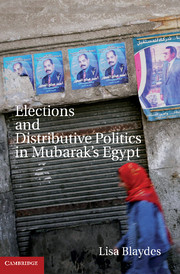Book contents
- Frontmatter
- Contents
- List of Figures
- List of Tables
- Acknowledgments
- 1 Introduction
- 2 Political and Economic Change since 1952
- 3 Elections and Elite Management
- 4 The Politics of Infrastructure Provision
- 5 Electoral Budget Cycles and Economic Opportunism
- 6 Vote Buying, Turnout, and Spoiled Ballots
- 7 Elections and Elite Corruption
- 8 Elections and the Muslim Brotherhood
- 9 Liberal Intellectuals and the Demand for Democratic Change
- 10 Foreign Pressure and Institutional Change
- 11 Egypt in Comparative Perspective
- 12 Conclusion
- Bibliography
- Index
4 - The Politics of Infrastructure Provision
Published online by Cambridge University Press: 04 February 2011
- Frontmatter
- Contents
- List of Figures
- List of Tables
- Acknowledgments
- 1 Introduction
- 2 Political and Economic Change since 1952
- 3 Elections and Elite Management
- 4 The Politics of Infrastructure Provision
- 5 Electoral Budget Cycles and Economic Opportunism
- 6 Vote Buying, Turnout, and Spoiled Ballots
- 7 Elections and Elite Corruption
- 8 Elections and the Muslim Brotherhood
- 9 Liberal Intellectuals and the Demand for Democratic Change
- 10 Foreign Pressure and Institutional Change
- 11 Egypt in Comparative Perspective
- 12 Conclusion
- Bibliography
- Index
Summary
One of the most important decisions facing the governments of both developed and developing countries involves how to distribute critical infrastructure resources given a country's budget constraint. In the developing world, improvements to basic infrastructure can make a profound difference in the health and well-being of populations and can particularly improve the lives and educational opportunities for girls and women who often (quite literally) carry the burden of poor infrastructure. Recent scholarly works have attempted to examine some of the political determinants of local economic development in a number of countries, including China, India, Japan, Mexico, and Peru (Schady 2000; Diaz-Cayeros et al. 2003; Parikh and Weingast 2003; Chhibber and Nooruddin 2004; Scheiner 2006; Magaloni 2006; Tsai 2007; Diaz-Cayeros, Estevez, and Magaloni 2007). These studies are informed by competing theories about how an incumbent should distribute selective resources, such as infrastructure and other public goods. Cox and McCubbins (1986) argue that incumbents may be risk-averse and as a result prefer to make transfers to core supporters. Lindbeck and Weibull (1987) suggest that transfers should instead go to swing voters. Dixit and Londregan (1996) contend that the choice between favoring swing voters or core supporters depends on a number of factors. For Bueno de Mesquita et al. (2003), leaders who need to reward a growing coalition of supporters will do so through the provision of public goods.
- Type
- Chapter
- Information
- Elections and Distributive Politics in Mubarak’s Egypt , pp. 64 - 76Publisher: Cambridge University PressPrint publication year: 2010

